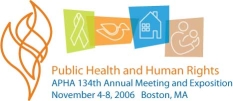 Back to Annual Meeting
|

|
 Back to Annual Meeting
|
APHA Scientific Session and Event Listing |
 Back to Annual Meeting
|

|
 Back to Annual Meeting
|
APHA Scientific Session and Event Listing |
Jeremy Shiffman, PhD, Public Administration, Syracuse University, 306 Eggers Hall, Syracuse, NY 13244, 315-443-4928, jrshiffm@maxwell.syr.edu
As attention by bilateral and multilateral donors to the prevention and treatment of HIV/AIDS increases, advocates for other health issues affecting the poor have expressed concern that this prioritization may adversely affect funding for and attention to other health and population causes. The precise influence of donor prioritization of HIV/AIDS prevention and control on funding for other health causes has not been evaluated empirically, however. This paper attempts to do so. I calculate the amount of funding given by major bilateral and multilateral donors year by year over twelve years – 1992 to 2003 – for six broad, historically prominent health agendas encompassing all health and population-related funding: HIV/AIDS prevention and control, reproductive health and population, the control of infectious diseases other than HIV/AIDS, basic healthcare, health sector strengthening, and nutrition.
I analyze funding trends to determine which agendas have been favored at which points in time, by which donors, and most critically, whether there is evidence that the HIV/AIDS agenda has adversely affected funding for other health causes. I consider these issues both with respect to aggregate deflated dollars and percentages of total health and population spending. I employ data from the OECD Development Assistance Committee's Credit Reporting System (CRS), the most comprehensive database of donor grants that exists.
Preliminary results show that the picture is far from black and white. With respect to the United States there do appear to be crowding-out effects: HIV/AIDS control as a percentage of total U.S. health and population aid rose from 10.5% in 1997 to 43.1% in 2003, while over the same time period the percentage for health sector strengthening declined from 22.8% to 0.5% and for reproductive health and population from 53.2% to 24.5%. On the other hand, when aid from all donors is considered, the increase for HIV/AIDS is less marked, and the decrease for other health and population causes less pronounced. There may therefore be crowding out effects; however, in aggregate donors may be compensating for the imbalances of particular members of their community.
Learning Objectives:
Keywords: HIV/AIDS, Policy/Policy Development
Presenting author's disclosure statement:
Not Answered
Handout (.ppt format, 87.5 kb)
The 134th Annual Meeting & Exposition (November 4-8, 2006) of APHA